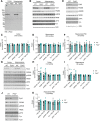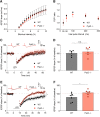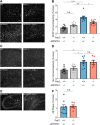Alzheimer's Disease Risk Factor Pyk2 Mediates Amyloid-β-Induced Synaptic Dysfunction and Loss
- PMID: 30518596
- PMCID: PMC6343652
- DOI: 10.1523/JNEUROSCI.1873-18.2018
Alzheimer's Disease Risk Factor Pyk2 Mediates Amyloid-β-Induced Synaptic Dysfunction and Loss
Abstract
Dozens of genes have been implicated in late onset Alzheimer's disease (AD) risk, but none has a defined mechanism of action in neurons. Here, we show that the risk factor Pyk2 (PTK2B) localizes specifically to neurons in adult brain. Absence of Pyk2 has no major effect on synapse formation or the basal parameters of synaptic transmission in the hippocampal Schaffer collateral pathway. However, the induction of synaptic LTD is suppressed in Pyk2-null slices. In contrast, deletion of Pyk2 expression does not alter LTP under control conditions. Of relevance for AD pathophysiology, Pyk2-/- slices are protected from amyloid-β-oligomer (Aβo)-induced suppression of LTP in hippocampal slices. Acutely, a Pyk2 kinase inhibitor also prevents Aβo-induced suppression of LTP in WT slices. Female and male transgenic AD model mice expressing APPswe/PSEN1ΔE9 require Pyk2 for age-dependent loss of synaptic markers and for impairment of learning and memory. However, absence of Pyk2 does not alter Aβ accumulation or gliosis. Therefore, the Pyk2 risk gene is directly implicated in a neuronal Aβo signaling pathway impairing synaptic anatomy and function.SIGNIFICANCE STATEMENT Genetic variation at the Pyk2 (PTK2B) locus is a risk for late onset Alzheimer's disease (AD), but the pathophysiological role of Pyk2 is not clear. Here, we studied Pyk2 neuronal function in mice lacking expression with and without transgenes generating amyloid-β (Aβ) plaque pathology. Pyk2 is not required for basal synaptic transmission or LTP, but participates in LTD. Hippocampal slices lacking Pyk2 are protected from AD-related Aβ oligomer suppression of synaptic plasticity. In transgenic AD model mice, deletion of Pyk2 rescues synaptic loss and learning/memory deficits. Therefore, Pyk2 plays a central role in AD-related synaptic dysfunction mediating Aβ-triggered dysfunction.
Keywords: Alzheimer's; Pyk2; amyloid; synapse.
Copyright © 2019 the authors 0270-6474/19/390758-15$15.00/0.
Figures








Similar articles
-
Pyk2 Signaling through Graf1 and RhoA GTPase Is Required for Amyloid-β Oligomer-Triggered Synapse Loss.J Neurosci. 2019 Mar 6;39(10):1910-1929. doi: 10.1523/JNEUROSCI.2983-18.2018. Epub 2019 Jan 9. J Neurosci. 2019. PMID: 30626696 Free PMC article.
-
The flavonoid baicalein rescues synaptic plasticity and memory deficits in a mouse model of Alzheimer's disease.Behav Brain Res. 2016 Sep 15;311:309-321. doi: 10.1016/j.bbr.2016.05.052. Epub 2016 May 24. Behav Brain Res. 2016. PMID: 27233830
-
Alzheimer risk gene product Pyk2 suppresses tau phosphorylation and phenotypic effects of tauopathy.Mol Neurodegener. 2022 May 3;17(1):32. doi: 10.1186/s13024-022-00526-y. Mol Neurodegener. 2022. PMID: 35501917 Free PMC article.
-
Synaptotoxic Signaling by Amyloid Beta Oligomers in Alzheimer's Disease Through Prion Protein and mGluR5.Adv Pharmacol. 2018;82:293-323. doi: 10.1016/bs.apha.2017.09.007. Epub 2017 Oct 25. Adv Pharmacol. 2018. PMID: 29413525 Free PMC article. Review.
-
Synaptic changes in Alzheimer's disease and its models.Neuroscience. 2013 Oct 22;251:51-65. doi: 10.1016/j.neuroscience.2012.05.050. Epub 2012 Jun 9. Neuroscience. 2013. PMID: 22687952 Review.
Cited by
-
Rhamnetin Prevents Bradykinin-Induced Expression of Matrix Metalloproteinase-9 in Rat Brain Astrocytes by Suppressing Protein Kinase-Dependent AP-1 Activation.Biomedicines. 2023 Dec 1;11(12):3198. doi: 10.3390/biomedicines11123198. Biomedicines. 2023. PMID: 38137419 Free PMC article.
-
Enhanced phagocytosis associated with multinucleated microglia via Pyk2 inhibition in an acute β-amyloid infusion model.J Neuroinflammation. 2024 Aug 6;21(1):196. doi: 10.1186/s12974-024-03192-7. J Neuroinflammation. 2024. PMID: 39107821 Free PMC article.
-
Pyk2 overexpression in postsynaptic neurons blocks amyloid β1-42-induced synaptotoxicity in microfluidic co-cultures.Brain Commun. 2020 Aug 28;2(2):fcaa139. doi: 10.1093/braincomms/fcaa139. eCollection 2020. Brain Commun. 2020. PMID: 33718872 Free PMC article.
-
Synaptic tau: A pathological or physiological phenomenon?Acta Neuropathol Commun. 2021 Sep 9;9(1):149. doi: 10.1186/s40478-021-01246-y. Acta Neuropathol Commun. 2021. PMID: 34503576 Free PMC article. Review.
-
A peptide inhibitor of Tau-SH3 interactions ameliorates amyloid-β toxicity.Neurobiol Dis. 2020 Feb;134:104668. doi: 10.1016/j.nbd.2019.104668. Epub 2019 Nov 5. Neurobiol Dis. 2020. PMID: 31698056 Free PMC article.
References
-
- Andreev J, Galisteo ML, Kranenburg O, Logan SK, Chiu ES, Okigaki M, Cary LA, Moolenaar WH, Schlessinger J (2001) Src and Pyk2 mediate G-protein-coupled receptor activation of epidermal growth factor receptor (EGFR) but are not required for coupling to the mitogen-activated protein (MAP) kinase signaling cascade. J Biol Chem 276:20130–20135. 10.1074/jbc.M102307200 - DOI - PubMed
Publication types
MeSH terms
Substances
Grants and funding
LinkOut - more resources
Full Text Sources
Medical
Molecular Biology Databases
Miscellaneous
